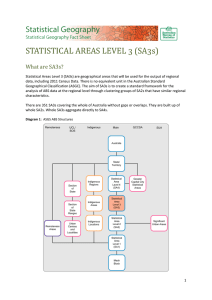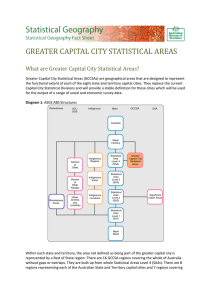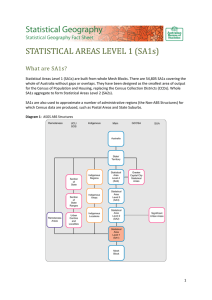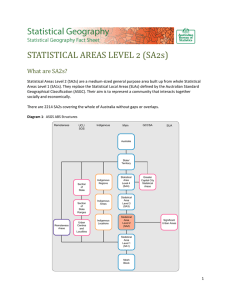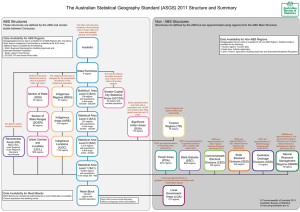Understanding ABS Statistical Geography
advertisement
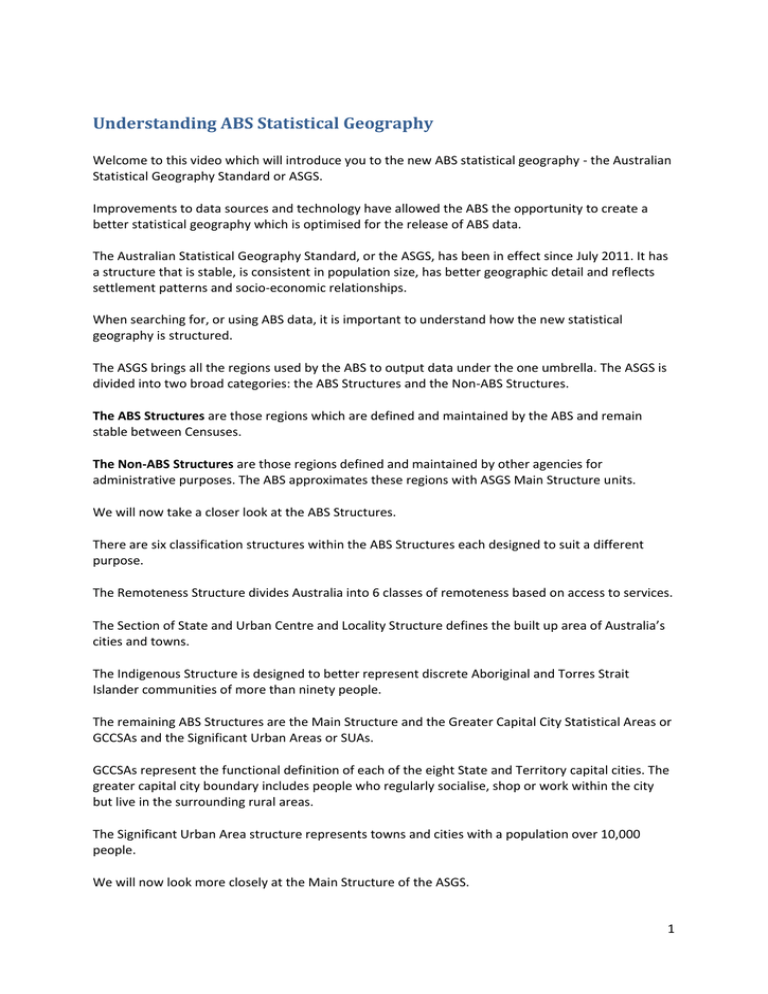
Understanding ABS Statistical Geography Welcome to this video which will introduce you to the new ABS statistical geography - the Australian Statistical Geography Standard or ASGS. Improvements to data sources and technology have allowed the ABS the opportunity to create a better statistical geography which is optimised for the release of ABS data. The Australian Statistical Geography Standard, or the ASGS, has been in effect since July 2011. It has a structure that is stable, is consistent in population size, has better geographic detail and reflects settlement patterns and socio-economic relationships. When searching for, or using ABS data, it is important to understand how the new statistical geography is structured. The ASGS brings all the regions used by the ABS to output data under the one umbrella. The ASGS is divided into two broad categories: the ABS Structures and the Non-ABS Structures. The ABS Structures are those regions which are defined and maintained by the ABS and remain stable between Censuses. The Non-ABS Structures are those regions defined and maintained by other agencies for administrative purposes. The ABS approximates these regions with ASGS Main Structure units. We will now take a closer look at the ABS Structures. There are six classification structures within the ABS Structures each designed to suit a different purpose. The Remoteness Structure divides Australia into 6 classes of remoteness based on access to services. The Section of State and Urban Centre and Locality Structure defines the built up area of Australia’s cities and towns. The Indigenous Structure is designed to better represent discrete Aboriginal and Torres Strait Islander communities of more than ninety people. The remaining ABS Structures are the Main Structure and the Greater Capital City Statistical Areas or GCCSAs and the Significant Urban Areas or SUAs. GCCSAs represent the functional definition of each of the eight State and Territory capital cities. The greater capital city boundary includes people who regularly socialise, shop or work within the city but live in the surrounding rural areas. The Significant Urban Area structure represents towns and cities with a population over 10,000 people. We will now look more closely at the Main Structure of the ASGS. 1 The Main Structure is based on the functional area of major cities and towns and gazetted Suburbs and Localities. The Main Structure has seven levels. The lowest level is called a Mesh Block. Mesh Blocks are the smallest geographic region. There are about 350,000 Mesh Blocks covering the whole of Australia. Mesh Blocks are represented here by yellow boundaries. Residential Mesh Blocks usually contain 30 to 60 households. Mesh Blocks are the building block for all the larger regions of the ASGS. At this geographic level, the ABS releases only the basic Census data of total population and dwelling counts. The next level in the ASGS Main Structure is the Statistical Area Level 1 or SA1. SA1s are built from whole Mesh Blocks. There are about 55,000 SA1s covering the whole of Australia and they have an average population of about 400 people. SA1s are represented here by blue boundaries. SA1s have been designed as the smallest unit for the release of data from the 2011 Census of Population and Housing. Here the SA1s are of an area of Sydney. Railway stations and railway lines are also shown for context. The next level in the ASGS Main Structure is the Statistical Area Level 2 or SA2. SA2s are built from whole SA1s. There are about 2,200 SA2s covering the whole of Australia and they have an average population of about 10,000. SA2s are represented here by orange boundaries. SA2s are a general purpose medium sized area and their aim is to represent a community that interacts together socially and economically. SA2s are the regions for which the majority of ABS substate and intercensal data will be released, for example Estimated Resident Population and Health and Vital Statistics. The next level in the ASGS Main Structure is the Statistical Area Level 3 or SA3. SA3s are built from whole SA2s. They are a medium sized region with a population range of 30,000 to 130,000. SA3s are represented here by green boundaries. SA3s represent the functional areas of regional towns and cities with a population in excess of 20,000 or clusters of related suburbs within the major urban areas. They are useful for comparing two or more larger regions. There are 351 SA3s covering the whole of Australia. The next level in the ASGS Main Structure is the Statistical Area Level 4 or SA4. SA4s are built from whole SA3s. They are the largest sub-State region with a minimum population of 100,000. SA4s are represented here by brown boundaries. SA4s are designed for the output of Labour Force data and they reflect labour markets. The next level of the structure is the State or Territory and the top level is Australia. You will find that most data on the ABS website is readily available by State or Territory. We will now look at the Non-ABS Structures of the ASGS The Non-ABS Structures bring together those regions which are not defined by the ABS, but which are important to users of ABS statistics. They generally represent administrative regions and their boundaries are approximated by ASGS Main Structure boundaries. 2 Local Government Areas are built from Mesh Blocks. Postal Areas, State Suburbs, Commonwealth Electoral Divisions and State Electoral Divisions are built from Statistical Areas Level 1 or SA1s. Natural Resource Management Regions (NRMR) and Australian Drainage Divisions (ADD) are also built from SA1s. NRMRs and ADDs are included in the new ABS statistical geography due to the demand for environmental statistics. Tourism Regions are built from Statistical Areas Level 2. For more information on the ASGS and any of the structures mentioned please refer to the Statistical Geography web portal. To access this site from the ABS home page, select the banner ‘Statistical Geography’ on the left hand navigator of the ABS home page under the ‘All Statistics’ heading. Or, you can simply type www.abs.gov.au forward slash geography to find the web site. The Geography web portal has some quick links to ‘What’s new in Statistical Geography’, and to ‘Most Commonly Requested Information’. The left hand navigator contains several chapters with comprehensive statistical geography information and resources. One of the chapters in the left hand navigator is ‘ABS Geography Publications’. Here you can access publications, digital boundaries and correspondences. Volumes that detail the ASGS Structures are the first publications listed on this web page. This is the main page of ASGS volume one. The ‘Downloads’ tab is where Digital boundaries for GIS, classification manuals and spread sheets of ASGS codes and labels are located. Thank you for watching this tutorial, we hope you found it useful. Detailed information on ABS Geography is found on the Statistical Geography web portal at: www.abs.gov.au/geography 3
